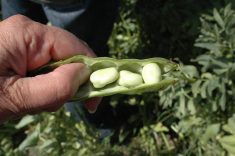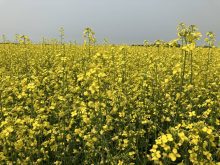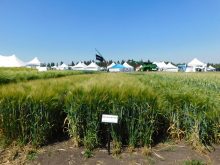Slow and steady will win the race for Peace Region producers this crop season. Heavy precipitation and cool temperatures for the majority of the growing season have put harvest operations about a month behind. We re just picking away at it, says Alberta Agriculture market specialist David Wong. Cool conditions, shorter days and sporadic showers are giving us trouble.
Many producers are forced to harvest their crops in tough and damp condition requiring drying. Though the north Peace, producers wrapped up harvest by the beginning of October, but they are the exception. The rest of the Peace is only about 70 per cent done, reported Wong on Oct. 30. Lots of guys aren t getting out there until three o clock in the afternoon these days, if at all.
Read Also

New crop insurer policy enables easier startup for faba beans
Agriculture Financial Services Corporation updated its normals for faba beans, which may open the door for more Canadian producers to feel comfortable growing the pulse crop in the future.
Powerful winds blew into the area Oct. 26 instead of the forecasted freezing rain and snow flurries, which helped harvest, Wong said. Thanks to the cooperation of Mother Nature, combines went hard right through the last weekend of October. He expects producers will complete harvest by the end of the first week of November. He said producers are busy just taking it off and not waiting for crops to dry down. As a result, grain bag sales are brisk. They allow you to take the grain off at a higher moisture content, and not have to truck it back to the yard right away, said Wong.
Custom combining is more frequent here this year, and it s not unusual to see six or seven combines in one field. Some guys who are already finished will go across the fence and help out their neighbour, said Wong. We re seeing lots of No. 1 and No. 2 wheat and canola and some exceptional cereal crops.
Fescue yields are about average, and that s from a significantly decreased acreage in northwestern Alberta. Many producers seeded wheat and canola instead to benefit from high market prices.
Good yields and quality
Yields have been solid, especially for wheat. According to the Oct. 20 Alberta Crop Report, Peace spring wheat is sitting at 96.2 per cent in the top three grades, the highest in the province. The provincial average was 88.9 per cent. The same holds true for barley at 96.9 per cent either select or 1 CW, compared to the provincial average of 87 per cent. Quality estimates for Peace region canola is 86.3 per cent No. 1, again higher than the provincial average of 79.7 per cent. Only field pea quality (at 57.6 per cent) were lower than the provincial average, by more than 10 per cent.
It s been one of the more difficult harvest seasons, even for the Peace area. Harvesting completion rates were spotty, even from one field to the next. It s the little rainfall every other day that was just enough to stop harvest operations, Wong said. We are at well-below-normal precipitation levels for this time of year.
Still, Peace soils are still well above average for rainfall received since April 1, and the subsurface moisture is generally good, he said. According to Alberta Agriculture, 57 per cent of Peace subsoil moisture ratings are rated as excellent, with another 37 per cent rated as good.
———
It sthelittlerainfall everyotherdaythat wasjustenough tostopharvest operations.
DAVID WONG














